Patrick Durrant | Sydney
Inmarsat president Global Government Andy Start is in Singapore for the company's annual Asia Partner conference and spoke with ADM about the recent Australian Border Force SATCOM upgrade as well as other solutions applicable to defence and government agencies.
The Australian Border Force recently became the first comprehensive customer for Inmarsat's high speed Ka band satellite network known as GlobalXpress (GX).
“It really stretches the GX system and allows us to demonstrate what it's capable of and why it's different.”
ABF Cape class patrol boats are now able to access both the GX and WGS satellite networks via the one terminal designed and manufactured by local Australian SME EM Solutions.
“Low cost flexibility from us with dedicated military capacity for WGS creates a really harmonious market for us.”
Start explained the ABF can access the WGS military Ka-bands but also has the ability to cut across onto Inmarsat commercial Ka-band services which provide it with global coverage.
He said the ABF feedback has been really positive, not merely in the sense that high speed broadband connectivity had provided superior operational capability but also in a welfare services sense for the ship's crew.
The addition of the EM Solutions Cobra antennas had meant the footprint on the vessels was much smaller, and other peripheral benefits were improved logistics support, because ABF could now synchronise their databases centrally and remotely.
 EM Solutions Cobra Ka-band terminal. Credit: Inmarsat
EM Solutions Cobra Ka-band terminal. Credit: Inmarsat
One trend he was seeing was the steady fall in cost per bit of SATCOM over recent years and Start said while commercial customers are generally spending more on telecommunications, they are leveraging improved connectivity to cut down on operational costs.
“For example, if you are able to conduct electronic systems training while crew are on the vessels you can use less overall crew to achieve the same operational outcome.”
Start said that while military SATCOM such as WGS could provide certain military features in a very high stress environment that couldn't be performed by commercial satellites, for the vast majority of cases commercial SATCOM can meet most of the operational needs of the military and of governments more broadly.
“The refresh rate of commercial satellites is one advantage, and Inmarsat normally launches one to two satellites per year and spends half a billion dollars on new space hardware and terminal equipment,” he said. “The networks are generally upgraded more often and therefore the blended cost per bit is more attractive than with military network.”
With Inmarsat terminals now broadly similar to those used with WGS, users have the choice, so long as they have the extension kit to access the GX spacecraft, to shift across from the WGS onto either Inmarsat military Ka services or onto commercial Ka services.
“Low cost flexibility from us with dedicated military capacity for WGS creates a really harmonious market for us,” Start said. “It's a real win-win.”
Regarding the Asia Partners Conference, Start said it was the biggest yet, with over 350 attendees from over 100 companies representing just about every country in the region. One of the topics being covered was the turbulent and uncertain geopolitical environment being seen globally and the repercussions this would have in the defence SATCOM space.
Start said that with seven out of the top ten defence spending nations in the world located in the Asia Pacific region and a more confident and rapidly growing China, there were interesting dynamics and tensions being created in the region.
Citing Northern Sky Research data that analysed potential growth in military SATCOM-on-the-move over the next nine to ten years, Start said that high throughput satellites such as GlobalXpress will be growing their capacity by at least seven times in that period.
Understanding the operational needs of its partner nations was crucial and underlined the importance of the conference, Start said, and telemedical services to field hospitals was just one of the examples where Inmarsat has been working closely with governement agencies. E-health, anti-terrorist solutions and, as per the Australian experience, border control, were other areas where the service could offer solutions.
New products with applications in the deployable defence capability in the land domain include the Paradigm Swarm45 which is a flat panel KA-band terminal that will fit into a rucksack or carry-on case and provide 2 Mbps upload and 4-5Mbps download speeds.




